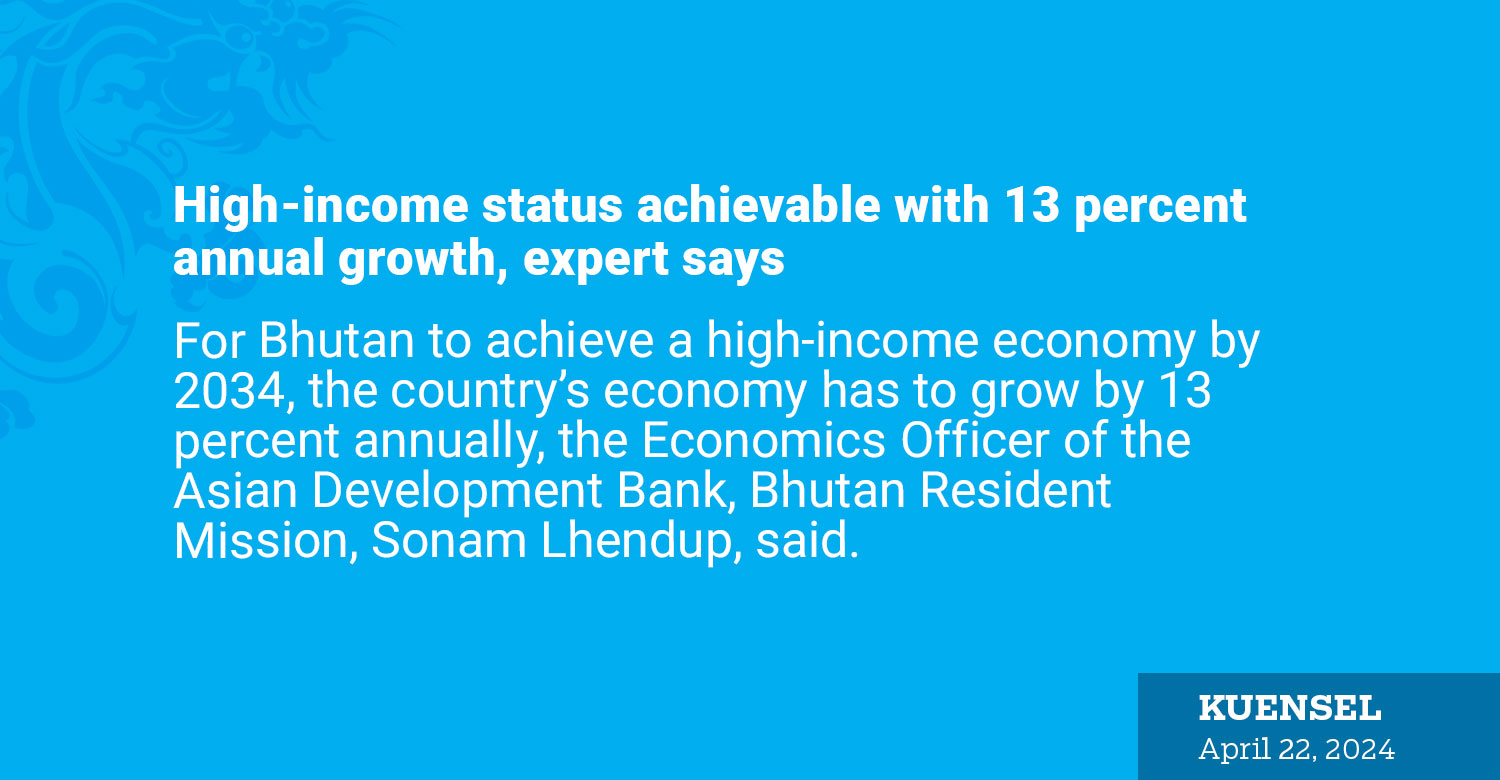
…govt. has to revise PPP policy for innovative financing
For Bhutan to achieve a high-income economy by 2034, the country’s economy has to grow by 13 percent annually, the Economics Officer of the Asian Development Bank, Bhutan Resident Mission, Sonam Lhendup, said.
Bhutan had set the goal with the aim of doubling the country’s gross domestic product (GDP) from USD 2.5 billion to USD 5 billion by the year 2029, aligned to the 13th Plan.
By 2034, Bhutan aims to achieve a high-income status with an economy valued at USD 10 billion.
The finance minister, Lekey Dorji, however, said that the high-income status by 2029 is achievable with the annual economic growth rate of eight percent with a multiplier effect during the recent meet-the-press session.
He added that the multiplier effect will come from an annual target of 300,000 tourists annually, Nu 100 billion foreign direct investments, planned hydropower projects out of the 13th Plan budget, and Gelephu Mindfulness City.
Applying the rule of 70, with an estimated country’s GDP of Nu 279.75 billion in 2024, for the economy to double to Nu 559.5 billion by 2029, it has to grow at 14 percent annually. The rule of 70 shows that the number of years it takes for a country’s economy to double in size is equal to 70 divided by the growth rate, in percent.
For the economy to grow between 12 to 13 percent, Sonam Lhendup said that Bhutan will require massive capital injection and radical policy changes including private sector engagement.
Sonam Lhendup said that Bhutan’s economic growth was largely driven by the public spending with capital accumulation over the past years, which is not sustainable because of the declining multiplier effect over the time.
Bhutan had experienced a multiplier effect of 2.6 in the 5th Plan, which tipped to 3.4 in the 9th Plan, and dropped to 2.9 in the 12th Plan.
The multiplier effect for the 12th Plan of 2.9 means that for every additional Nu 1 the government spends, GDP is boosted by Nu 2.9.
For the 13th Plan, Sonam Lhendup said that the expected resources gap was USD 700 million or 9 percent of the GDP with government resources and tax revenue estimated between 12 to 15 percent of the GDP. At the same time, he added that the government of India’s (GoI) financing per plan has been declining over the years.
The GoI financing per plan had been declining from 100 percent in the 1st Plan, 42 percent in the 6th Plan, and 21 percent in the 11th Plan.
The government had estimated a total budget outlay of Nu 512.48 billion for the 13th Plan—Nu 250 billion for capital and Nu 262.48 billion for current expenditure.
With challenges of declining multiplier effect and financing, Sonam Lhendup said that Bhutan has to adopt innovative financing by leveraging public private partnerships (PPP) and attracting private sector participation which will bridge the country’s fiscal gap, generate employment, and foster partnerships between the government and private sector.
Calling for policy changes, he said that there are challenges of implementing PPP projects because of complex institutional settings, centralised approval system, limited awareness of PPPs, and scarcity of successful examples.
For the success of the PPP, Sonam Lhendup said that it requires enhanced capacity to structure and negotiate contracts, shareholder awareness-leadership, select projects for quick wins, create conducive business environment, and reforming state-owned enterprises.
The Bank had projected Bhutan’s economy to grow at 4.4 percent this year and 7 percent next year because of the growth in service and energy sectors.
The finance ministry projects the economy to grow at 5.68 percent this year and 8.97 percent in 2025.
Meanwhile, the GDP growth rates were recorded at 4.4 percent in 2021, 5.2 percent in 2022, and estimated 3.2 percent in 2023.












